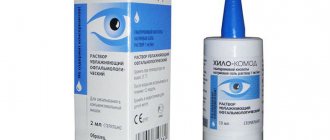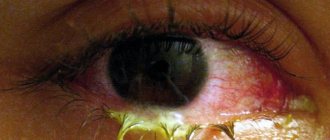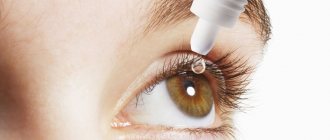In what cases are vasoconstrictor eye drops needed?
The main symptom when this drug is necessary for drug treatment is redness of the eyes.
Know! It can occur for various reasons, but, in most cases, external vasoconstrictor drugs are the best and fastest way to address pathological symptoms.
For redness of the eyes associated with external causes
There are several reasons for this inflammatory process, sometimes they differ from each other quite noticeably:
- TV and , in particular, computers can become enemies of your vision if you are near a monitor or screen for more than 6 hours a day;
- negative environmental situation ; exhaust gases from cars, emissions of harmful substances into the atmosphere from enterprises - all this irritates the mucous membrane of the organ of vision;
- Redness is often caused by an allergic reaction; it can be either seasonal or sudden when an irritant appears;
- dry eyes due to dysfunction of the lacrimal glands;
- mechanical damage to the cornea;
- improper wearing of contact lenses;
- vascular diseases of various pathologies;
- cold or dry climate , unusual for the body.
For ophthalmological diseases
Note! In many cases, redness of the eyes (sometimes even very severe) can cause serious illnesses:
- conjunctivitis. This is a purulent inflammation of the mucous membrane; It can be of allergic or viral or bacterial origin. In all cases, the use of drops gives a certain positive effect;
- blepharitis. This inflammation of the eyelid margin often causes intense redness;
- glaucoma. This disease is characterized primarily by an increase in intraocular pressure, due to which small vessels rupture;
- colds, diabetes.
Recommendations for selection and use
You should choose eye drops with a vasoconstrictor effect only on the recommendation of an ophthalmologist. The cause of redness can be a serious illness, and self-medication often leads to a worsening of the patient’s condition.
If the doctor has prescribed several types of eye drops, you should take breaks of at least 15 minutes between instillations. Before using eye drops, you should wash your hands thoroughly. To avoid infection of the medicinal solution, avoid touching the tip of the dropper to the patient's eyes. Most drops lose their medicinal properties a month after opening the bottle. Medicines that have expired should be thrown away and replaced with new drops. If the problem does not disappear within 4-5 days of treatment, you must inform your doctor.
Principle and duration of action
The main component of such drugs are adrenergic agonists .
These substances target receptors on the walls of blood vessels .
As a result of this active effect, redness, swelling, itching and burning are quickly localized . The person ceases to experience persistent discomfort.
However, frequent and long-term use of these medications may eventually cause the opposite effect.
After 5 days, the drops begin to become addictive, and then even provoke a complication of the disease. The redness may become permanent. Therefore, you should not get carried away only with this method of treatment.
In addition, eye drops do not treat the disease itself , which causes redness, but only its symptoms .
Keep in mind! The use of vasoconstrictor drops is effective only in complex treatment and interaction with other medications.
Otherwise, the benefit from the drug will only be temporary, and the disease, having adapted to it, will develop with renewed vigor.
Complex action drugs
These are eye drops, where the alpha-adrenergic agonist is supplemented with other active ingredients, therefore they have both a vasoconstrictor effect and an antiseptic, antihistamine, and antiallergic effect.
Diabenil
Used for blepharitis and allergic conjunctivitis. Produced in 10 ml bottles. The main active ingredients are:
- Diphenhydramine hydrochloride (1 mg per 1 ml of the drug) - this substance belongs to the group of ethanolamines and is an antihistamine. It is thanks to it that H1-histamine receptors are blocked, which leads to the complete elimination or reduction of allergic reactions;
- naphazoline hydrochloride (300 mcg per 1 ml of the drug) - this substance is a-adrenomimetic, due to which it is possible to relieve irritation of the conjunctiva, redness and burning, swelling, and narrow blood vessels.
Among the other components in the composition, boric acid should be highlighted; it has an antispasmodic local anesthetic effect.
Used from the age of 2 years. Children under 12 years of age receive 1-2 drops up to 3 times during the day, and adults - 4-5 times . Treatment time is up to 1 week. In case of severe diseases, the treatment time should be repeated after a week.
The pupils may dilate, this happens within half an hour. Burning, itching and dry eyes are possible. Long-term use may affect the patient's well-being in the form of dizziness, general weakness, and drowsiness.
The product is prohibited for use in case of hypersensitivity to the substances that are included in its composition. This is also relevant for corneal dystrophy, acute glaucoma, prostate hypertrophy, bronchial asthma, and poor production of ocular fluid. The product is prohibited for pregnant women and during lactation. It is undesirable to combine with the use of products containing heavy metal salts.
Cheaper analogues of Diabenil are Betacrin and Okumetil drops.
Spersallerg
It is used in the case of hay fever, vernal or infectious conjunctiva, inflammatory and allergic diseases.
The drug contains the following substances: tetrizoline (0.5 mg) and antazoline hydrochloride (0.6 mg). It is produced in a bottle with a 10 ml pipette.
After administration, the drug begins to cause two reactions: antiallergic and vasoconstrictor. After its use, irritation and swelling are relieved, and blood vessels constrict.
Adults are required to drip 1 drop every 3 hours , and after a course of therapy to maintain the result - 2-3 times 1 drop throughout the day.
Children should not drip more than 1-2 drops throughout the day. If you have contact lenses, they are removed before instillation and put on only 20 minutes after the procedure. Use may cause some negative effects:
- after the course, the eye vessels turn red;
- there is a burning sensation in the eyes;
- pupils enlarge;
- headache appears;
- blood pressure increases;
- feels drowsy;
- Tachycardia is noted, especially when the patient is a small child.
The use of the drug should be avoided in case of open-angle glaucoma, hypersensitivity, use of MAOIs, Sjögren's syndrome or dry eye. Patients with diabetes mellitus, severe forms of cardiovascular disease, hyperthyroidism and hypertension should be approached with great caution when using the product.
Alergophthal
Prescribed by an ophthalmologist during allergic conjunctiva.
The two main active ingredients are naphazoline hydrochloride (0.25 mg per 1 ml of the drug) and antazoline phosphate (5 mg per 1 ml of the drug). It has a triple effect: antihistamine, antiallergic and vasoconstrictor. After using the medicine, the hyperemia and itching go away.
It is necessary to drip 1-2 drops throughout the day. If other eye drops are used, the interval between their applications is more than 10 minutes. After opening the bottle, the drug must be used for up to a month.
If after use for three days there is no positive effect, or the condition worsens, then you need to stop using it and consult an ophthalmologist. Using the medicine may cause heart rhythm disturbances, increased blood or intraocular pressure, and dilated pupils.
It is prohibited to use Alergoftal in case of pulmonary heart failure, hypersensitivity, prostate adenoma, closed-angle glaucoma, pregnancy and lactation, hypertension. You cannot combine the use of drops with antidepressants and MAOIs.
Opcon-A
Prescribed by an ophthalmologist for redness, itching and allergic inflammation of the eyes. The drug belongs to the group of adrenomimetic and antihistamine drugs.
The active ingredients of the drug are pheniramine (3.15 mg per 1 ml of the drug) and naphazoline hydrochloride (0.26 mg per 1 ml of the drug). The pharmacy sells the product in bottles of 3 and 15 ml. During the day, drop 4 times 1-2 drops, but before that you need to remove the lenses.
There may be a tingling sensation in the eye, which will go away after a while. It is forbidden to use in children under 6 years of age, with pulmonary heart failure, excessive sensitivity, angle-closure glaucoma, hypertension, lactation, pregnancy, prostate adenoma.
Possible contraindications
Before you figure out how and what drops should be used, you need to consider the cases under which they are not recommended to be used.
There is a list of conditions and diseases for which such drugs are contraindicated:
- they should not be taken by pregnant or breastfeeding women ;
- with great caution they are prescribed to children in a certain dosage and at a certain age ;
- with glaucoma - narrowing of blood vessels provokes an increase in eye pressure;
- for cardiovascular diseases and arterial hypertension ;
- in case of detection of diabetes mellitus ;
- for dry eye syndrome; this is the name for serious inflammation of the lacrimal glands, which can be treated for a long time with other drugs;
- drops of this kind are strictly contraindicated for people suffering from individual intolerance to naphazoline and tetrizoline - these drugs are the basis of such drugs.
It is worth noting! Some experts argue that eye redness caused by working on a computer and subsequent drying out of the mucous membrane cannot be treated with such drops.
But there are also opinions to the contrary. In any case, treatment here must be approached on a purely individual basis.
List of drugs
Today, pharmacies are literally overflowing with effective drops with a vasoconstrictor effect. We can highlight only the most effective ones:
- Visine . This medicine helps relieve hyperemia and swelling of the eyes. But it has some side effects, one of which is addiction. So you need to use the drug for no longer than 4 days. Apply 1-2 drops 3 times a day. The drug should not be prescribed during pregnancy or in young patients. Vizin is also contraindicated for people with blood pressure changes. The cost of the medicine is 300-500 rubles.
- Octilia. These drops can instantly stop eye hyperemia, and the narrowing effect is noticeable within a few minutes. Since the composition contains antiseptic components, it is effective to use the medicine for the treatment of conjunctivitis.
- Naphthyzin. These drops can quickly narrow the blood vessels of the visual organs when the cause of redness lies in allergies or mechanical influence. Drip the drug 3 times a day. Since Naphthyzin is addictive, you should not use it for more than 4 days. The next side effect is pupil dilation, so driving or working on a computer is not recommended. The cost of the medicine is 30 rubles.
- Visomitin. The peculiarity of the drug is that its components deeply affect the cause of redness. The medicine is prescribed to people with age-related changes in the visual organs. Visomitin can also be used in combination with other drugs to restore the eye mucosa. He will strengthen his influence. The dosage and duration of therapy is determined taking into account the cause of vasodilation and the doctor must prescribe the drug individually. Its cost is 500 rubles.
- Okumetil. This medicine has a complex effect. It is possible to relieve hyperemia, swelling, and inflammation of the eyes. Cannot be used for more than 3 days. Side effects include burning, itching, and decreased visual acuity. It should not be prescribed to pregnant women or patients with diabetes. The cost of the medicine is 180 rubles.
Visine is a drug with a vasoconstrictor effect.
If there is no positive effect, then you should visit a doctor.
- Alomide . This drug is designed to eliminate redness caused by allergies. There are no side effects, but it is not recommended to use it for longer than a week. The price of the drug is 180-250 rubles.
The most effective means
Visine
- Visine is one of the most common broad-spectrum drugs;
- relieves redness, swelling, itching;
- Visible improvement begins within 5-7 minutes;
- the drug is active for 5-8 hours;
- especially effective for allergic reactions and conjunctivitis;
- has a significant list of side effects: pupil dilation, sometimes pain, burning, blurred vision;
- Pregnant women should not use it;
- average price – 280 rub.
Polinadim
- combined action drug – contains naphthyzine and diphenhydramine;
- effective against allergies;
- It is not recommended to use for longer than 5 days;
- 1 drop is instilled 2-3 times a day, for children over 2 years old - 1 time;
- may cause itching and burning;
- pregnant women - only in extreme cases;
- the bottle cannot be frozen and stored after opening for more than 1 month;
- In pharmacies these drops cost about 80 rubles.
Okumetil
- a combination medicine consisting of naphazoline, diphenhedramine and zinc sulfate;
- in addition to the main one, it also has a disinfecting effect;
- apply no longer than 3 days;
- instillation mode – 1 drop 3 times a day;
- especially contraindicated for bronchial asthma;
- price 150 rub.
Octilia
- octilium begins to act within 2 minutes;
- applied 2 times a day;
- most active in conjunctivitis;
- It is not recommended to go out into the cold after use;
- contains antiseptic components;
- in pharmacies it costs 300 rubles.
Naphthyzin
- the most affordable remedy;
- the drug has proven itself well for mechanical eye injuries;
- It is prohibited to use more than 3 times a day;
- causes very rapid addiction depending on the individuality of the patient’s body;
- Causes rapid pupil dilation, so it should not be used immediately before driving a car or working on a computer.
- costs from 30 rubles.
Visomitin
- vizomitin is one of the most effective and gentle drugs;
- often prescribed to older patients;
- for computer syndrome does not give negative side effects;
- enhances the effect of concomitant medications;
- dosage and frequency of use are interrelated with other medications:
- In pharmacies it sells from 500 rubles.
Alomid
- mainly fights allergic reactions;
- has virtually no side effects;
- is not addictive;
- can be used for up to 4 weeks;
- after instillation in the area of the pupil, discomfort is possible;
- costs 240 rubles.
Vidisik
- Vidisik relieves dryness of the mucous membrane of the eye;
- ineffective for allergies
- causes visual impairment in some patients
- costs 250-300 rubles.
Types of vasoconstrictor eye drops
Vasoconstrictor eye drops based on the main active ingredient can be divided into:
- products based on tetrizoline - Vizin, Octilia, Visoptic, Montevisin, Neosin;
- preparations with naphazoline – Naphthyzin;
- combined agents – Okumetil, Polinadim.
Visine
A drug based on tetrizoline, a substance that has a stimulating effect on α-adrenergic receptors. The drug is characterized by a pronounced vasoconstrictor and anti-edematous effect, slows down the production of eye fluid, and dilates the pupil. The therapeutic effect of the drug develops within a minute after instillation and lasts 4–8 hours.
Directions for use: 1-2 drops 2 to 4 times a day, no longer than 4 days.
If the dose, frequency and duration of use are exceeded, the drug causes systemic side effects - increased blood pressure, increased heart rate, nausea, agitation and confusion.
Octilia
An analogue of Visine based on tetrizoline. In addition to the vasoconstrictor component, the drops contain chamomile and linden extracts, which effectively relieve inflammation, burning and soreness, and soothe irritated eyes. The product begins to act a few minutes after instillation, the therapeutic effect lasts 4–8 hours.
Directions for use: 1-2 drops 2-3 times a day, no longer than 4 days.
When using drops for a longer time, the likelihood of developing side effects increases - eye pain, tearing, increased swelling and redness, increased intraocular pressure and deterioration of visual function.
Naphthyzin
Naphthyzin vasoconstrictor eye drops should be used only as prescribed by your doctor.
Vasoconstrictor drops based on naphazoline. The product effectively eliminates swelling and redness, reduces tearing, burning and discomfort, and dilates the pupil. The therapeutic effect develops a couple of minutes after instillation of the solution and lasts several hours.
Directions for use: 1-2 drops 2-3 times a day, no longer than 3-4 days.
The drug has a wide list of contraindications; in case of overdose, it provokes the development of systemic side effects - headache, nausea, heart rhythm disturbances, increased blood pressure, insomnia.
Okumetil
A combination drug containing:
- naphazoline (vasoconstrictor component);
- diphenhydramine (antiallergic component, H1-histamine receptor blocker);
- zinc sulfate (anti-inflammatory and antiseptic).
The components included in the drug act comprehensively: they reduce the intensity of the inflammatory process, disinfect, eliminate redness, swelling, itching, burning, tearing and other unpleasant symptoms that occur with allergies, irritation and inflammatory diseases of the eyes.
Directions for use: drops into the affected eye 2-3 times a day for 3 days.
After instillation, the components of the solution are absorbed into the bloodstream and have a systemic effect. In this regard, eye drops have a wide range of contraindications (epilepsy, bronchial asthma, prostate hyperplasia, diseases of the cardiovascular system, stenosis of the bladder neck and others) and are used strictly as prescribed by the doctor.
Polinadim
Polinadim vasoconstrictor drops effectively eliminate redness and swelling in allergic and infectious eye diseases.
Combined drops containing naphazoline (vasoconstrictor) and diphenhydramine (H1-histamine receptor blocker). The drops have a pronounced vasoconstrictor and antihistamine effect, quickly relieve swelling, reduce itching and lacrimation.
Mode of application: drop by drop every 3 hours until the intensity of symptoms decreases, then drop by drop up to 3 times a day, no longer than 5 days.
Exceeding the dosage and frequency of use can provoke clouding of the cornea, increased local adverse reactions (burning in the eyes, deterioration of visual function). It is also possible to develop systemic effects (increased heart rate, increased blood pressure, headache and dizziness, tremor, nausea, drowsiness), especially in children and the elderly.
Redness of the eyes occurs not only as a result of exposure to irritating external factors, but also with various ophthalmological diseases - conjunctivitis, uveitis, blepharitis, corneal ulceration, glaucoma. Before using vasoconstrictor eye drops, you should consult an ophthalmologist to make an accurate diagnosis.
The specialist will determine the exact cause of redness and swelling, and in addition to symptomatic vasoconstrictors, will prescribe medications to treat the underlying disease that caused the unpleasant symptoms. Improper treatment can lead to worsening inflammatory processes in the eye, the development of complications and deterioration of vision.
List of inexpensive drugs with improved action
It should be noted! These, in addition to some of those in the list above, include:
- tobrex; the price of the drug is 150 -170 rubles, but in comparison with the price its effectiveness is very high;
- tauphone; costs from 130 rubles, but can be used for a month;
- tsipromed; can be purchased for 140 rubles, effective against bacterial infection;
- pure tear ; the drug is almost similar in composition to natural tears, therefore it does not cause allergic reactions; available from 140 rub.
Indications for use
The drug is prescribed for redness of the eye. This may occur in the following cases:
- Adverse weather conditions. If a person has walked for a long time in windy weather, the eyes may turn red. Blood vessels also dilate in cold or dry climates.
- Long hours of work at the computer, painstaking work that requires increased attention.
- Schoolchildren often have red eyes because their eyes have been strained for a long time.
- Allergies and irritations. If an allergy occurs, it is recommended to consult a doctor. Select a medicine suitable for the patient and find out the cause of the allergic reaction.
- Damage to the cornea (mechanical damage, burns, foreign body entry).
- Infectious inflammations.
- Incorrectly fitted contact lenses.
- The eyes may turn red due to pathologies of the vascular system.
- Unfavorable environmental situation in the city. Smoke, dust, debris.
Patients whose work involves constant strain on the visual system are prescribed vasoconstrictor eye drops as a preventative measure.
Many vasoconstrictors are available without a prescription, but it is recommended that they be used only after being prescribed by an ophthalmologist. If drops are used without a prescription, use with extreme caution. If there is a negative effect, it is recommended to stop taking the drug. If redness of the eyes does not go away, consult an ophthalmologist for advice.
Features of action and application
The composition of vasoconstrictors usually includes α-adrenergic agonists - substances that act on the receptors of the vascular walls. As a result of this effect, the lumen of the blood vessels narrows, which eliminates swelling and redness of the mucous membrane of the eyes, and reduces other symptoms of inflammation - discomfort, burning, itching, lacrimation.
Vasoconstrictor drugs eliminate symptoms, but do not act on the cause of their occurrence, do not treat the underlying disease, and are used exclusively to reduce/eliminate the clinical manifestations of the disease in combination with other medications.
Ophthalmologists prescribe eye drops with a vasoconstrictor effect in short courses. With prolonged use (longer than 3-5 days), addiction develops, persistent dilatation of the vessels of the conjunctival membrane may occur, as a result of which the redness will become permanent.
In addition, with the constant use of drugs in this group, the course of the underlying disease may worsen, since the narrowing of the lumen of blood vessels disrupts the blood supply and nutrition of the tissues of the eye. Any eye solutions with a vasoconstrictor effect should be used only as prescribed by a doctor.











